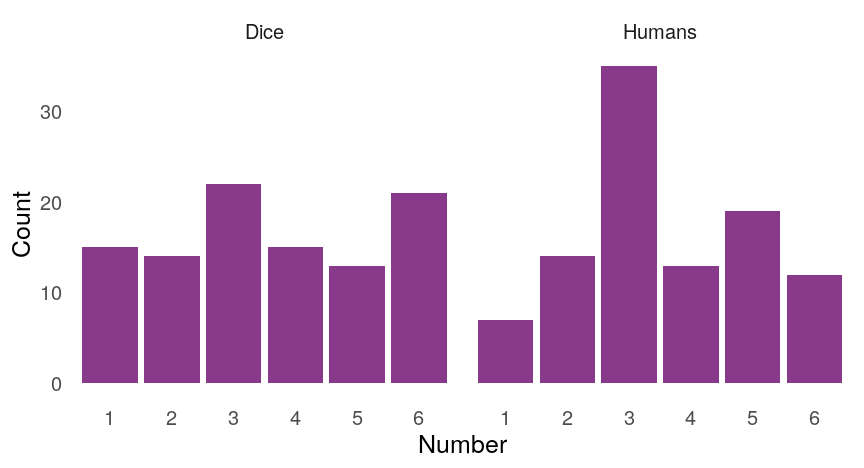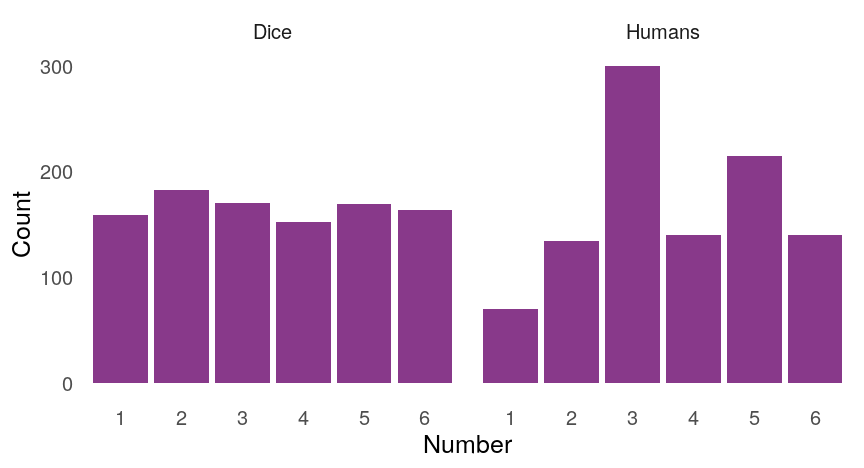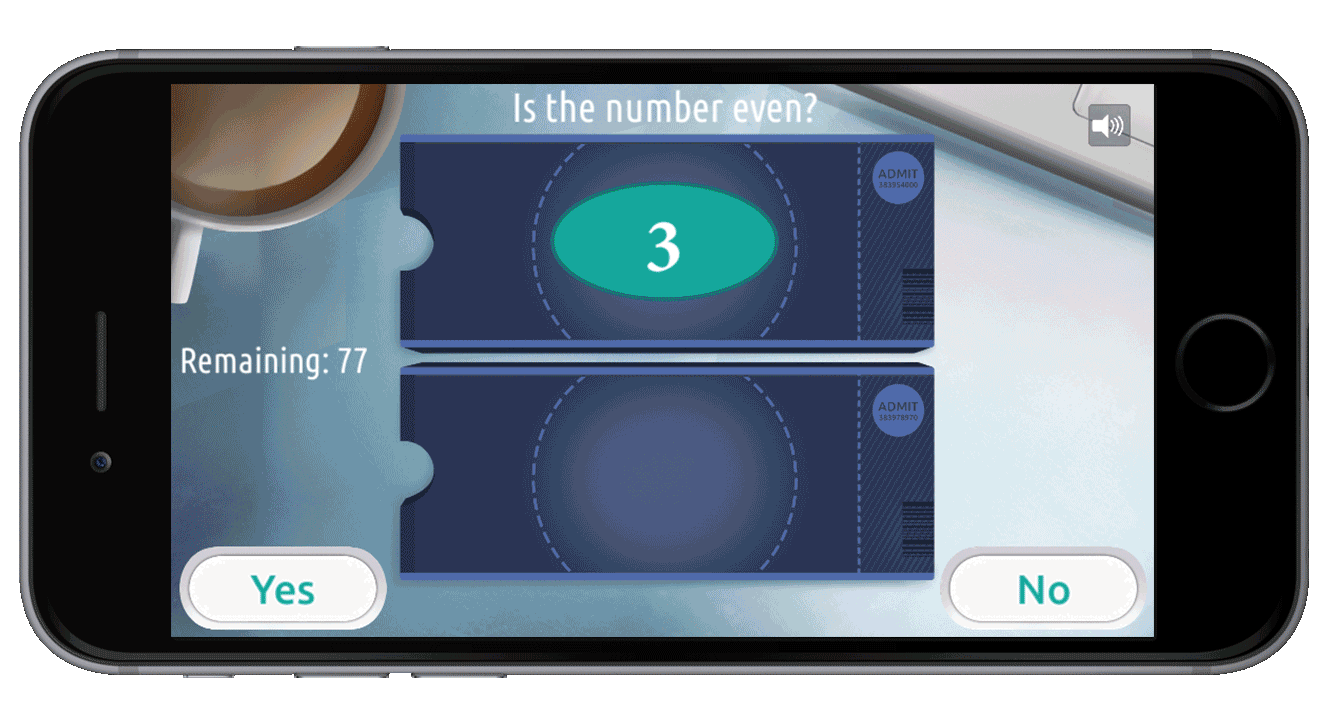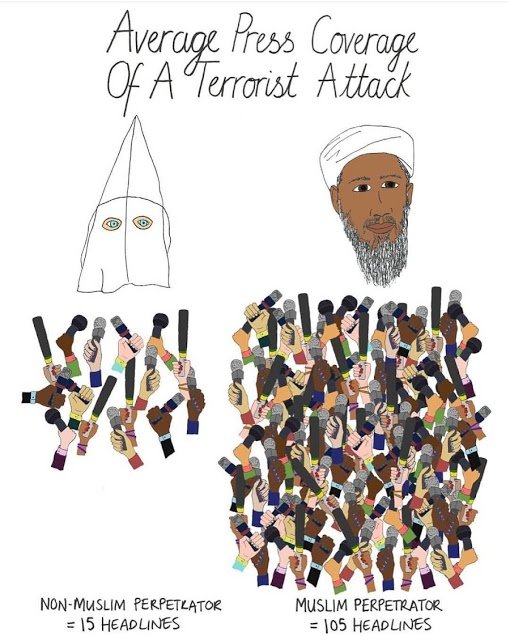class: center, middle, inverse, title-slide # You can be a data detective ## Florence Nightingale Day ### Rhian Davies ### 2019-01-10 --- <!--Abstract: Humans are bad at dealing with randomness and probabilities - we ignore the obvious and see patterns in the ordinary. It's my job to decide whether differences in the data are due to chance or a real underlying cause. Stories of real projects (personality and deodorant) and discuss the pitfalls that we humans often stuggle with #chakra: libs\remark-latest.min.js --> # Randomly choose a number between 1 and 6... <!-- Everyone, choose a number between 1 and 6. Just choose the first number you thing of. Stick with it. Ok, hands up if you chose the number 3...? How about 6?--> -- <!-- --> --- # Randomly choose a number between 1 and 6... <!-- --> --- # Let's try tossing a coin. -- <!-- Increase size The Gambler’s Fallacy – a trick of the brain that leads us to think that if something hasn’t happened for a long time, it is more likely to happen again. If a coin lands on heads three times, for instance, it instinctively feels like it should land on tails – but there is an equal chance of it landing on heads again --> ## H T T H H T T H H T T T T T H T H H T T T T T T T H T H T H --- class: center, middle <!--You’re listening to music on shuffle, and an artist appears twice in a row. It feels like more than a coincidence – perhaps your music player is playing tricks on you, or has chosen favoured artists – but is it? In fact, music players tend not to shuffle randomly. But that’s because if it did, it would actually feel less random. Human brains will start seeing patterns in even the smallest coincidences – and in a long shuffled playlist, it’s likely that certain songs or artists will come next to one another. “The problem is that to humans, truly random does not feel random,” Mattias Petter Johansson, a Spotify developer, wrote in an internet post earlier this month. “So we got tons of complaints from users about it not being random. “Last year, we updated it with a new algorithm, that is intended to feel more random to a human.” The feeling that playlists are being played with comes partly from the Gambler’s Fallacy – a trick of the brain that leads us to think that if something hasn’t happened for a long time, it is more likely to happen again. If a coin lands on heads three times, for instance, it instinctively feels like it should – but there is an equal chance of it landing on heads again. That means that if a playlist repeats artists, songs or genres then it feels wrong. If shuffle is truly random, the Gambler’s Fallacy leads us to think, then the songs should be more spaced out. But there is an equal chance that songs will come close together as there is that they will be far apart-->  --- # What is a statistician? <!-- Insert google image searches--> -- * My job to decide whether differences in data are due to __random chance__ or a __real underlying cause__. * Play with other people's data * Meet lots of interesting people --- # Reality check: do speed cameras reduce serious road accidents?  --- class:center <!-- Unilever: Global 169,000 employees over - R&D over 6000, 15 people in my group owns over 400 brands, 100 countries Arctic Shores: Scale up, 30 employees across 3 offices (Man, London, Singapore) Many different people - one DS Digital Rail: 2 employees across one office * Unilever want to understand how consumers use deodorant. * Experimental participants are notoriously bad at filling in study diaries. * Unilever developed data loggers to collect user data in a less intrusive and more reliable way. * Can we learn how consumers use deodorant just using the logger data?--> <img src="images/unilever.png" height = "150"> .pull-left[ <center><img src ="images/rexona.png" alt="Roll on deodorant" style="width: 180px;"/></center> ] .pull-right[<center><img src="images/datalogger.jpg" alt="Data Loggers" style="width: 300px;"/></center>] --- class: center <img src="images/as.png" height = "100"> --  --- class: center   --- class: center, inverse, middle <img src="images/hannah_fry.jpg" height = "350"> <img src="images/mona_c.jpg" height = "350"> @ FryRsquared @MonaChalabi @trianglegirl --- class: center, inverse, middle  --- class: center, inverse, middle 